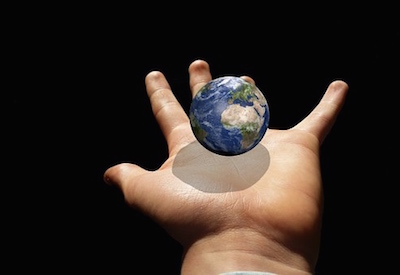The World Bank’s Year in Review: 2016

January 16, 2017
By Tariq Khokhar
Between the social, political, and economic upheavals affecting our lives, and the violence and forced displacement making headlines, you’d be forgiven for feeling gloomy about 2016. A look at the data reveals some of the challenges we face but also the progress we’ve made toward a more peaceful, prosperous, and sustainable future.
1. The number of refugees in the world increased
At the start of 2016, 65 million people had been forcibly displaced from their homes, up from 60 million the year before. More than 21 million were classified as refugees. Outside of Sub-Saharan Africa, most refugees live in cities and towns, where they seek safety, better access to services, and job opportunities. A recent report on the “forcibly displaced” offers a new perspective on the role of development in helping refugees, internally displaced persons and host communities, working together with humanitarian partners. Among the initiatives is new financial assistance for countries such as Lebanon and Jordan that host large numbers of refugees.
2. The global climate change agreement entered into force
The pact negotiated in Paris in 2015 was ratified by 118 of the 194 countries that signed it, triggering new commitments to combat global warming. One of the agreement’s major goals is to promote a shift to low-carbon energy. Demand for renewable energy is picking up in developing countries as prices decline. In May, Africa saw its lowest solar price to date when the winning bid to develop large-scale photovoltaic solar plants in Zambia came in at 6 cents per kilowatt hour – or 4.7 cents/kwh, spread over 20 years. That followed bids as low as 3 cents in the United Arab Emirates and 4.5 cents in Mexico. Renewables are now cost competitive in many markets and increasingly seen as mainstream sources of energy, according to REN21.
3. Global trade weakened
In 2016, global trade growth recorded its weakest performance since the global financial crisis. Trade volumes stagnated for most of the year, with weak global investment playing an important role, as capital goods account for about one third of world goods trade. Trade has been a major engine of growth for the global economy and has helped cut global poverty in half since 1990. A trade slowdown, therefore, could have implications for growth, development, and the fight against poverty.
4. More people had access to mobile phones than to electricity or clean water
Access to mobile phones has surged in low- and middle-income countries, but many of the other benefits of the digital revolution — such as greater productivity, more opportunity for the poor and middle class, and more accountable governments and companies — have not yet spread as far and wide as anticipated, according to the World Bank’s 2016 world development report on the Internet, Digital Dividends. The report says greater efforts must be made to connect more people to the Internet and to create an environment that unleashes the benefits of digital technologies for everyone.
5. A third of all people were under the age of 20
In around 40 African countries, over 50% of the population is under 20. By contrast, in 30 richer countries, less than 20% of the population is under 20. As the 2015/2016 Global Monitoring Reports notes, the world is on the cusp of a major demographic transition that will affect countries along the development spectrum.
6. 600 million jobs will be needed in the next 10 years
One third of the world’s 1.8 billion young people are not currently in employment, education or training. Of the one billion more youth who will enter the job market in the next decade, only 40% are expected to be able to get jobs that currently exist. The future of work is changing, and the global economy will need to create 600 million jobs over the next 10 years to keep pace with projected youth employment rates.
7. 1 in 3 people did not have access to a toilet
The UN estimates that 2.4 billion people still lack access to improved sanitation facilities, nearly one billion of whom practice open defecation. Good sanitation is a foundation for development: conditions such as diarrhea are associated with poor sanitation, and left untreated can lead to malnutrition and stunting in children. This year’s first High-Level Panel on Water brought together world leaders with a core commitment to ensuring the availability and sustainable management of water and sanitation for all.
8. Most of the world’s extreme poor lived in Sub-Saharan Africa and South Asia
While over 1 in 10 people lived in extreme poverty globally in 2013, in Sub-Saharan Africa, that figure was 4 in 10, representing 389 million people. That’s more poor people than all other regions combined, according to the World Bank’s Poverty and Shared Prosperity report… but extreme poverty is declining worldwide. And while the numbers of extremely poor remain unacceptably high, data in the report reveal the tremendous progress the world has made lifting people out of poverty since 1990.
9. By 2030, two thirds of the world will live in cities
The world’s 12 largest city areas are each home to more than 15 million people, and over the last 25 years cities such as Delhi, Shanghai and Beijing have tripled in size. Today, more than half the world lives in cities, and those cities are responsible for more than 80% of global GDP. However, the high density of people, jobs, and assets that make cities so successful also make them vulnerable to the wide range of natural and man-made shocks and stresses increasingly affecting them today. The Investing in Urban Resilience report discusses how cities can take action to build resilience, protect hard-won development gains, and create a safer, more prosperous future.
10: A record number of economies carried out business reforms
Doing Business 2017 found that 137 economies worldwide implemented 283 business regulatory reforms last year. This represents an increase of more than 20% over the previous year. Areas of reform included starting a business, paying taxes, getting credit, and registering property. Notably, 54 of the world’s poorest countries implemented 113 reforms, and New Zealand ranked first in the ease of doing business among 190 economies.
11. Tobacco smoking has increased in over 20 countries
Smoking rates went up between 2000 and 2015 in a number of mostly low- and middle-income countries. In Indonesia, for example, the rate went up by almost 30% over the period, making the country home to more than 70 million smokers. Tobacco use kills 6 million people a year — one person every six seconds. If left unchecked, this number could rise to 8 million a year by 2030.
12.The world’s poorest countries got a record level of support
A coalition of more than 60 governments representing both developed and developing countries committed to a record US$75 billion replenishment for the International Development Association (IDA), the World Bank’s fund for the poorest. Over the past 25 years, countries assisted by IDA have seen progress on many fronts. These include greater access to clean water and sanitation, improvements in school completion rates, and higher rates of childhood vaccination.
Tariq Khokhar is a data scientist and The World Bank’s Global Data Editor. His interests lie where technology, development and data meet. He enjoys communicating with data, works on developing new methods for creating, analyzing and visualizing data, and on making data openly accessible for public re-use. He’s a mathematician and computer scientist by training, is a graduate of the University of Cambridge and currently lives in Washington, DC.
Photo courtesy of Pixabay.











